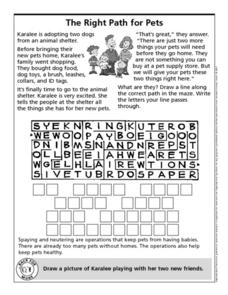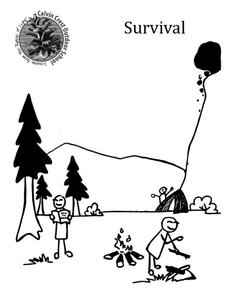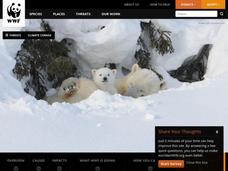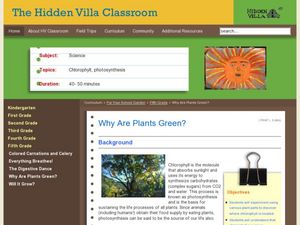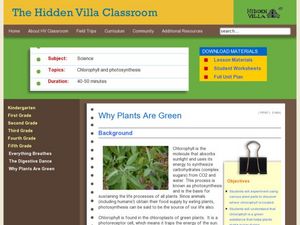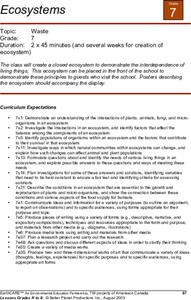Curated OER
Winter Survival
Students examine what animals need in order to survive. In this investigative lesson students play a "role" of an animal in winter.
University of South Carolina
Home Sweet Home
Fifth graders will research a biome (land or aquatic) and create a project (diorama, model or another idea of the student's choosing) which includes the geographic features of that biome as well as plants and animals found there and...
Curated OER
Habitat Lap Sit
Students examine through role play interdependence of animal and man in their search for the proper arrangement of food, water, shelter and space in the same regions. Students then discuss necessary components of suitable habitat.
Curated OER
Adaptations
Young scholars identify what adaptation is and to research a specific mollusk. They also identify and interpret how animals get their common and scientific name and why it is Latin. Finally, students draw their shell (mollusk) and name...
Curated OER
INDUSTRY AND THE ENVIRONMENT
Seventh graders create a final project called Industry X (which was previously researched in the unit) has plans to build in town. There is a special town meeting scheduled to discuss this matter and allow everyone to express their...
Curated OER
Mini-Ecosystems
Third graders identify the living and non living things in a book read aloud and discuss the interactions represented in the book. Then, they research and include a list of food that each animal needs in an ecosystem. Finally, 3rd...
Curated OER
Sharing Our Knowledge
Students evaluate their participation in an animal welfare service project. In this animal welfare lesson, students reflect upon their experience by using their feelings and descriptions in their writing. Students share their experiences.
Curated OER
Ecosystems
Third graders identify and define an Ecosystem and the basic needs of all animals. They collect pond water in a pickle jar. They observe the organisms that are in the jar to keep an ongoing record of the creatures and their population.
Curated OER
The Right Path for Pets
In this animal care worksheet, learners learn the important steps to take before adopting a dog from an animal shelter. Students follow a maze of letters which eventually tell them about spay/neutering for pets.
Curated OER
Hunting, Farming and Market Gardening
Students examine the hunting and farming practices of the Black Pioneer. They identify crops raised by black pioneers, and explore the contribution of children to the success of the family farm. Students explore the importance of...
Curated OER
Indicator Species
Pupils explore the ecological foundation of India's and ways to save the forests, water and the India tiger. After a lecture on identifying a healthy forest and the importance of the animals, students participate in activities to...
Curated OER
Habitat Is Home
Learners are introduced to the concept and components of a habitat. They discuss the key components of a habitat and describe how certain factors can cause disturbances in a habitat and change its population. Activities are leveled for...
Calvin Crest Outdoor School
Survival
Equip young campers with important survival knowledge with a set of engaging lessons. Teammates work together to complete three outdoor activities, which include building a shelter, starting a campfire, and finding directions in the...
Curated OER
Seed Swapping
Here is a fabulous, cross-curicular lesson on seeds. Elements of science, writing, math, agricultural practices, and art are all brought into this incredibly thorough plan. Additionally, a fun whole-class game is presented, and there is...
Curated OER
Marine & Aquatic Habitats Activities - Aquatic Animals
Students explore importance of marine or aquatic habitats, and investigate habitat characteristics and conditions required by various organisms to ensure survival. They then select an animal to study and design an artificial habitat...
Oklahoma State University
Hairy Heredity
Young scholars learn that heredity comes down to the flip of a coin with this cross-curricular math and science lesson. Using smiley faces as a model, young scholars toss coins to determine which dominant or recessive...
Curated OER
Climate Change And Disease
Students consider the role of climate change in the occurrence of vector born diseases such as malaria. In small groups, they research a specific vector to complete an information chart on climate changes in the region where the vector...
Curated OER
Why Are Plants Green?
Pupils smash plant parts and wait for visibility of chlorophyl to show why plants turn green. In this green plants lesson plan, students use acetone and filter paper for this experiment.
Curated OER
Where Are the Dinosaurs
Students explore the concept of extinction. In this dinosaur lesson, students view a video and have a class discussion about the extinction of dinosaurs. They create a dinosaur egg and imagine what life would be like for a dinosaur.
Curated OER
Learn About Dinosaurs
Students read facts about dinosaurs and then participate in a variety of dinosaur activities. In this dinosaur lesson plan, students paint dinosaur eggs, play dinosaur bingo, and more.
Curated OER
Why Plants Are Green
Young scholars discover the properties of chlorophyll in plants. In this plant biology lesson, students conduct an experiment to find where the chlorophyll in the plant is located. Young scholars are split into small groups and study...
Curated OER
Ecosystems
Seventh graders create a closed ecosystem and place it where is it visible to others in the school. They label it with posters describing the interdependence of living things in the ecosystem. They discuss what might happen to the...
Curated OER
Deer: Predation or Starvation
In this predation or starvation worksheet, students read about the effects of the wildlife service bringing in predators (wolves) to control a deer population. Students calculate the change in the deer population from 1971 to 1980. They...
Curated OER
Deer: Predation or Starvation
In this balance of nature worksheet, learners use a data chart to graph wolf and deer populations over a ten-year period. Students use this graph to complete 3 short answer questions.








